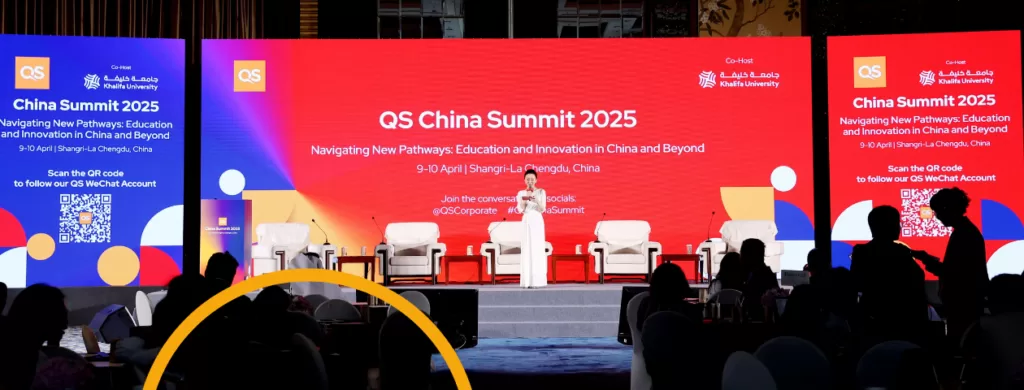
Following India’s recent success in the QS World University Rankings by Subject 2024, Dr Vidya Yeravdekar, Chair of the FICCI Higher Education Committee and Pro-Chancellor of Symbiosis International University, explores the value Indian institutions, and their prospective students, can find in university rankings.
Quality benchmarks can be seen in all sorts of industries – from a mason sculpting a statue to a manufacturing semiconductor. One cannot discount the role and influence standardisation has on the world. Without development and improvement, we’d face naturalisation of complacent and rigid institutions.
That may sound dramatic, but when we’re looking at higher education and its sphere of influence, improvement is a pressing issue. Global higher education directly contributes to boosting economic growth, improving social progress, elevating the quality of life, and reducing socioeconomic inequities. To progress, institutions require constructive and critical assessments based on quality parameters in the form of benchmarks and standards.
Indian improvements
Universities in the Global North tell us about their ‘rankings fatigue,’ but for institutions based in emerging markets, a good world ranking can put a university on the map.
In the QS World University Rankings 2024, 45 Indian higher education institutions feature in the list, compared to just 12 in 2014. Our ranking framework promotes and celebrates the institutions willing to excel across different quality parameters. Of course, rankings and accreditation frameworks are not foolproof. While they provide a powerful snapshot, rankings can be considered fundamentally simplistic and reductionist, but they do offer data-led insights for all stakeholders of education. They try to provide a holistic assessment of the quality of an institution via historic and contemporary data, along with global surveys.
As Ben Sowter, Vice President at QS Quacquarelli Symonds, says: “Our ranking mechanism does not attest to be an exact science; rather, it is a culmination of research into various factors and parameters that give students the information they need to make an educated decision about their college search”.
How do rankings support institutions?
Rankings, and to a great extent, accreditations, ratings and any other standardisation and quality benchmark can support:
Quality assessment: Parameters such as faculty credentials, student-faculty ratio, research output, and the kind of resources that are available to students and stakeholders are factored in to provide a measure of academic quality. QS rankings particularly applies affiliation caps, normalisation and damping to deter any short-term gains for institutions.
Comparative analysis: By first forming a matrix of the above factors around a single university, and then extending that to become a comparison between several universities, students can identify trends in higher education that speak directly to their needs. Assessing different institutions in terms of overall reputation, student satisfaction, graduation and retention rates, resources and facilities, and the university’s approach to diversity and inclusion, particularly for those choosing to study abroad, can go a long way in helping the student choose the institution better.
International outlook: For students considering studying abroad, universities that are globally engaged can be indicative of strong networking opportunities, cultural exchanges, or a more diverse learning experience and alumni.
Increased credibility: A well-ranked university will have a good reputation among academics and employers – these metrics make up 45% of a university’s rank in the QS World University Ranking. It’s a beneficial cycle, as students graduating from a well-ranked university then enhances their employability in the job market. Employers usually seek students from high-ranked institutions during campus placement or head-hunting initiatives.
Global ranking frameworks have been used for comparative assessment. They often serve as a tool for self-assessment and improvement for universities, encouraging them to strive for excellence in teaching, research, and overall institutional performance. As Peter Drucker, a world-leading management expert, said “If you can’t measure it, you can’t improve it.”
Criticism of the quality of education in Indian institutions is an age-old stereotype of many individuals, and special interest groups. However, we must acknowledge the positive impact of ranking and accreditation frameworks. Due to these metrics, Indian universities are now more focused on improving their infrastructure, facilities, faculty quality, and curriculum, so they can compete on the national and international stage.
Rankings have helped Indian institutions to specialise in their areas of interest and establish niche centres of excellence. Accreditations, on the other hand, assure quality and accountability in Indian universities. NAAC and NBA accreditations demonstrate institutional commitment towards high educational standards – QS Stars and QS I-GAUGE offer similar benefits. Without a guiding framework, academic institutions would be shooting in the dark, leading to chaos, uncertainty, and a lax attitude on behalf of the administration.
William Edwards Deming, the father of quality management, said “Without data, you’re just another person with an opinion.”, and if India needs to progress, we need to look at data more carefully –
- India has 116,000 startups, many of which are from our higher educational institutions.
- India’s research output is the fourth highest in the world, just behind China, the United States, and the United Kingdom – and this is with just 18% the number of researchers China has and 5% that of the US.
- India overtook China in the overall institutions ranked in the 2024 edition of QS University Rankings: Asia.
The evolution of our higher education system – underpinned by a data-driven approach to quality assessment and improvement – ensures that the future of Indian academia is bright, promising, and aligned with the global quest for knowledge and innovation.



